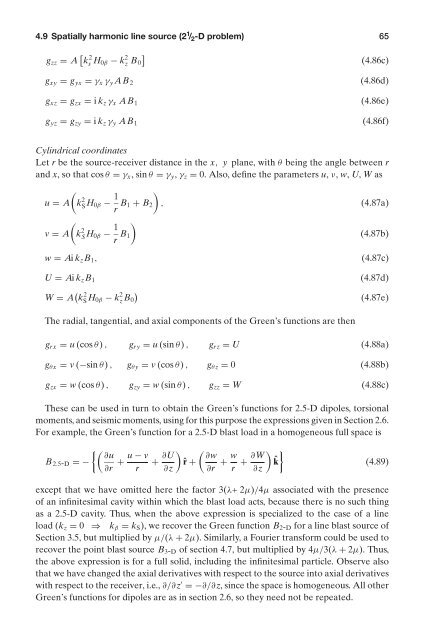Eduardo Kausel-Fundamental solutions in elastodynamics_ a compendium-Cambridge University Press (2006)
Create successful ePaper yourself
Turn your PDF publications into a flip-book with our unique Google optimized e-Paper software.
4.9 Spatially harmonic l<strong>in</strong>e source (2 1 / 2 -D problem) 65<br />
g zz = A [ ks 2 H 0β − k 2 z B ]<br />
0<br />
(4.86c)<br />
g xy = g yx = γ x γ y AB 2<br />
g xz = g zx = i k z γ x AB 1<br />
g yz = g zy = i k z γ y AB 1<br />
(4.86d)<br />
(4.86e)<br />
(4.86f)<br />
Cyl<strong>in</strong>drical coord<strong>in</strong>ates<br />
Let r be the source-receiver distance <strong>in</strong> the x, y plane, with θ be<strong>in</strong>g the angle between r<br />
and x, so that cos θ = γ x , s<strong>in</strong> θ = γ y , γ z = 0. Also, def<strong>in</strong>e the parameters u, ν, w, U, W as<br />
u = A<br />
(k 2 S H 0β − 1 )<br />
r B 1 + B 2 , (4.87a)<br />
(<br />
v = A k 2 S H 0β − 1 )<br />
r B 1<br />
(4.87b)<br />
w = Ai k z B 1 ,<br />
U = Ai k z B 1<br />
W = A ( kS 2 H 0β − k 2 z B )<br />
0<br />
(4.87c)<br />
(4.87d)<br />
(4.87e)<br />
The radial, tangential, and axial components of the Green’s functions are then<br />
g rx = u (cos θ) , g ry = u (s<strong>in</strong> θ) , g rz = U (4.88a)<br />
g θ x = v (−s<strong>in</strong> θ) , g θy = v (cos θ) , g θz = 0 (4.88b)<br />
g zx = w (cos θ) , g zy = w (s<strong>in</strong> θ) , g zz = W (4.88c)<br />
These can be used <strong>in</strong> turn to obta<strong>in</strong> the Green’s functions for 2.5-D dipoles, torsional<br />
moments, and seismic moments, us<strong>in</strong>g for this purpose the expressions given <strong>in</strong> Section 2.6.<br />
For example, the Green’s function for a 2.5-D blast load <strong>in</strong> a homogeneous full space is<br />
{( ∂u<br />
B 2.5-D =−<br />
∂r + u − v + ∂U<br />
r ∂z<br />
) ( ∂w<br />
ˆr +<br />
∂r + w r + ∂W ) }<br />
ˆk<br />
∂z<br />
(4.89)<br />
except that we have omitted here the factor 3(λ+2µ)/4µ associated with the presence<br />
of an <strong>in</strong>f<strong>in</strong>itesimal cavity with<strong>in</strong> which the blast load acts, because there is no such th<strong>in</strong>g<br />
as a 2.5-D cavity. Thus, when the above expression is specialized to the case of a l<strong>in</strong>e<br />
load (k z = 0 ⇒ k β = k S ), we recover the Green function B 2-D for a l<strong>in</strong>e blast source of<br />
Section 3.5, but multiplied by µ/(λ + 2µ). Similarly, a Fourier transform could be used to<br />
recover the po<strong>in</strong>t blast source B 3-D of section 4.7, but multiplied by 4µ/3(λ + 2µ). Thus,<br />
the above expression is for a full solid, <strong>in</strong>clud<strong>in</strong>g the <strong>in</strong>f<strong>in</strong>itesimal particle. Observe also<br />
that we have changed the axial derivatives with respect to the source <strong>in</strong>to axial derivatives<br />
with respect to the receiver, i.e., ∂/∂z ′ =−∂/∂z, s<strong>in</strong>ce the space is homogeneous. All other<br />
Green’s functions for dipoles are as <strong>in</strong> section 2.6, so they need not be repeated.



